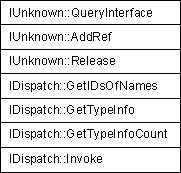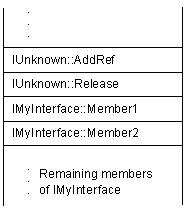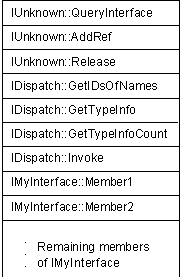
ActiveX clients can access objects in two different ways:
An Automation interface is a group of related functions that provide a service. All ActiveX objects must implement the IUnknown interface because it manages all of the other interfaces that are supported by the object. The IDispatch interface, which derives from the IUnknown interface, consists of functions that allow access to the methods and properties of ActiveX objects.
A custom interface is a COM interface that is not defined as part of OLE. Any user-defined interface is a custom interface.
The VTBL lists the addresses of all the properties and methods that are members of an object, including the member functions of the interfaces that it supports. The first three members of the VTBL are the members of the IUnknown interface. Subsequent entries are members of the other supported interfaces.
The following figure shows the VTBL for an object that supports the IUnknown and IDispatch interfaces.

If an object does not support IDispatch, the member entries of the object's custom interfaces immediately follow the members of IUnknown. For example, the following figure shows the VTBL for an object that supports a custom interface named IMyInterface.

When an object for Automation is exposed, you must decide whether to implement an IDispatch interface, a VTBL interface, or both. Microsoft strongly recommends that objects provide a dual interface, which supports both access methods.
In a dual interface, the first three entries in the VTBL are the members of IUnknown, the next four entries are the members of IDispatch, and the subsequent entries are the addresses of the members of the dual interface.
The following figure shows the VTBL for an object that supports a dual interface named IMyInterface:

In addition to providing access to objects, Automation also provides information about exposed objects. By using IDispatch or a type library, an ActiveX client or programming tool can determine which interfaces an object supports, as well as the names of its members. Type libraries, which are files or parts of files that describe the type of one or more ActiveX objects, are especially useful because they can be accessed at compile time. For information on type libraries, refer to "What Is a Type Library?" later in this chapter, and "Type Libraries" in Chapter 2, "Exposing ActiveX Objects."